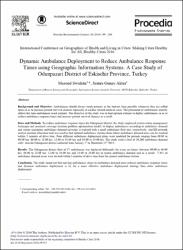| dc.contributor.author | Swalehe, Masoud | |
| dc.contributor.author | Aktaş, Semra Günay | |
| dc.contributor.editor | Lai, PC | |
| dc.contributor.editor | Low, CT | |
| dc.contributor.editor | Wong, PPY | |
| dc.date.accessioned | 2019-10-23T17:56:17Z | |
| dc.date.available | 2019-10-23T17:56:17Z | |
| dc.date.issued | 2016 | |
| dc.identifier.issn | 1878-0296 | |
| dc.identifier.uri | https://dx.doi.org/10.1016/j.proenv.2016.09.033 | |
| dc.identifier.uri | https://hdl.handle.net/11421/22904 | |
| dc.description | International Conference on Geographies of Health and Living in Cities - Making Cities Healthy for All (H-Cities) -- JUN 21-24, 2016 -- Univ Hong Kong, Hong Kong, PEOPLES R CHINA | en_US |
| dc.description | WOS: 000387507400032 | en_US |
| dc.description.abstract | Background and Objective: Ambulances should always reach patients in the shortest time possible whenever they are called upon so as to increase patient survival chances especially in cardiac related medical cases. The placement of ambulances directly affects the time ambulances reach patients. The objective of the study was to find optimal stations to deploy ambulances so as to reduce ambulance response times and increase patient survival chances as a result. Data and Methods: To reduce ambulance response times for Odunpazari district, the study employed system status management technique and maximal coverage location problem optimization model, to deploy ambulances according to ambulance demand and ensure maximum ambulance demand coverage is realized with a small ambulance fleet size, respectively. ArcGIS network analyst location allocation tool was used to find optimal ambulance stations from where ambulance demand areas can be reached within 5 minutes of drive time. Four different ambulance deployment plans were modeled for periods ranging from 00:00 to 06:00 hrs, 06:00 to 12:00 hrs, 12:00 to 18:00 hrs and 18:00 to 24:00 hrs. The study used a total of 20,260 ambulance demand calls' data for Odunpazari district collected from January 1st to December 31st 2014. Results:The Odunpazari district fleet of 17 ambulances was deployed differently for every six hours; between 00:00 to 06:00 hrs, 06:00 to 12:00 hrs, 12:00 to 18:00 hrs and 18:00 to 24:00 hrs to match ambulance demand and as a result, 77.6% of ambulance demand areas were located within 5 minutes of drive time from the nearest ambulance station. Conclusion:The study found out that moving ambulances closer to ambulance demand areas reduces ambulance response times and dynamic ambulance deployment is by far a more effective ambulance deployment strategy than static ambulance deployment. | en_US |
| dc.description.sponsorship | Univ Hong Kong, Dept Geography, HKU Geograph Informat Syst Res Ctr, Hong Kong Geograph Informat Syst Assoc, Australian Res Council Ctr Excellence Climate Syst Sci, Int Geospatial Health Res Network | en_US |
| dc.language.iso | eng | en_US |
| dc.publisher | Elsevier Science BV | en_US |
| dc.relation.ispartofseries | Procedia Environmental Sciences | |
| dc.relation.isversionof | 10.1016/j.proenv.2016.09.033 | en_US |
| dc.rights | info:eu-repo/semantics/openAccess | en_US |
| dc.subject | Ambulance Response Times | en_US |
| dc.subject | Dynamic Ambulance Deployment | en_US |
| dc.subject | Maximal Coverage Location Problem | en_US |
| dc.title | Dynamic Ambulance Deployment to Reduce Ambulance Response Times using Geographic Information Systems: A Case Study of Odunpazari District of Eskisehir Province, Turkey | en_US |
| dc.type | conferenceObject | en_US |
| dc.relation.journal | International Conference On Geographies of Health and Living in Cities: Making Cities Healthy For All | en_US |
| dc.contributor.department | Anadolu Üniversitesi, Yer ve Uzay Bilimleri Enstitüsü | en_US |
| dc.identifier.volume | 36 | en_US |
| dc.identifier.startpage | 199 | en_US |
| dc.identifier.endpage | 206 | en_US |
| dc.relation.publicationcategory | Konferans Öğesi - Uluslararası - Kurum Öğretim Elemanı | en_US] |


















